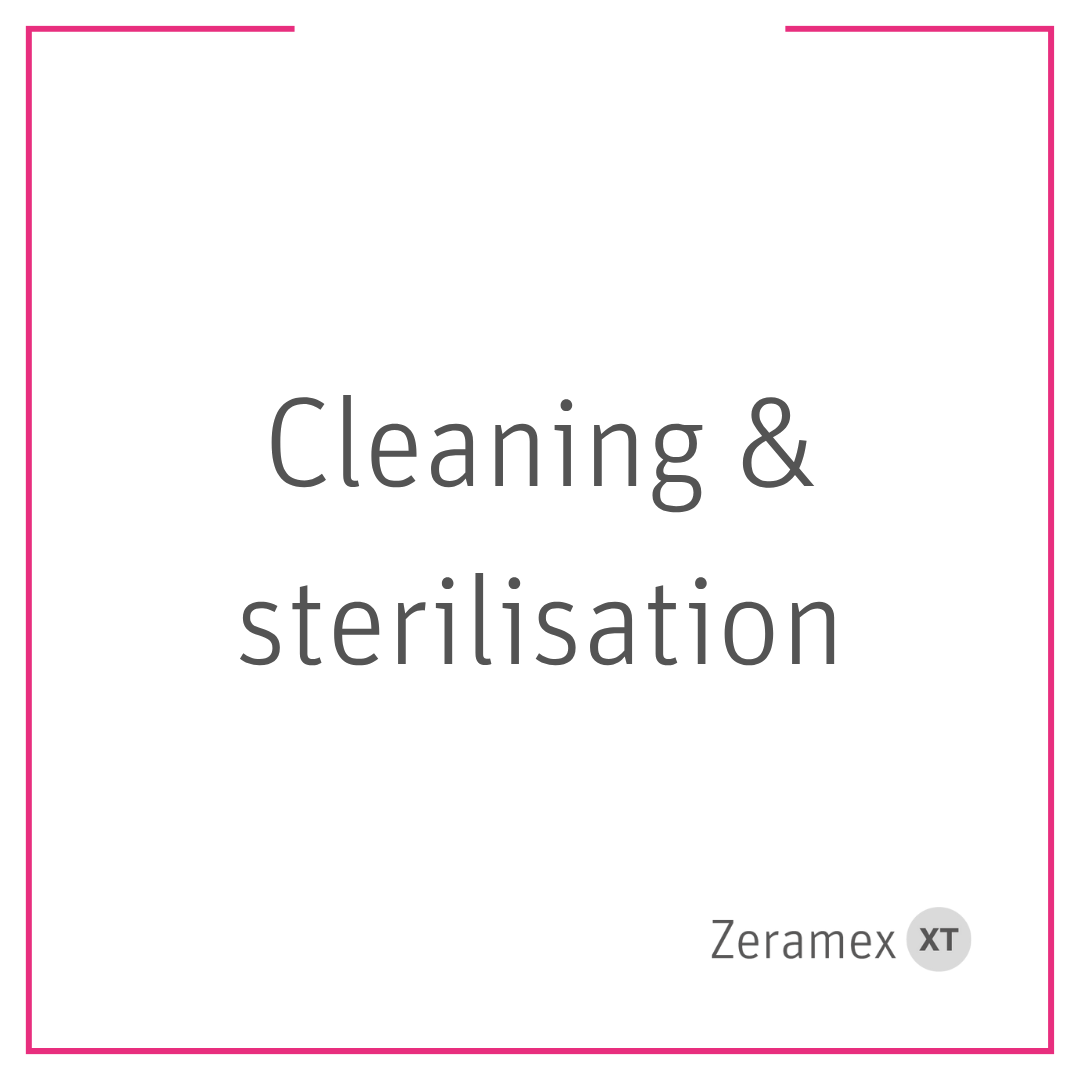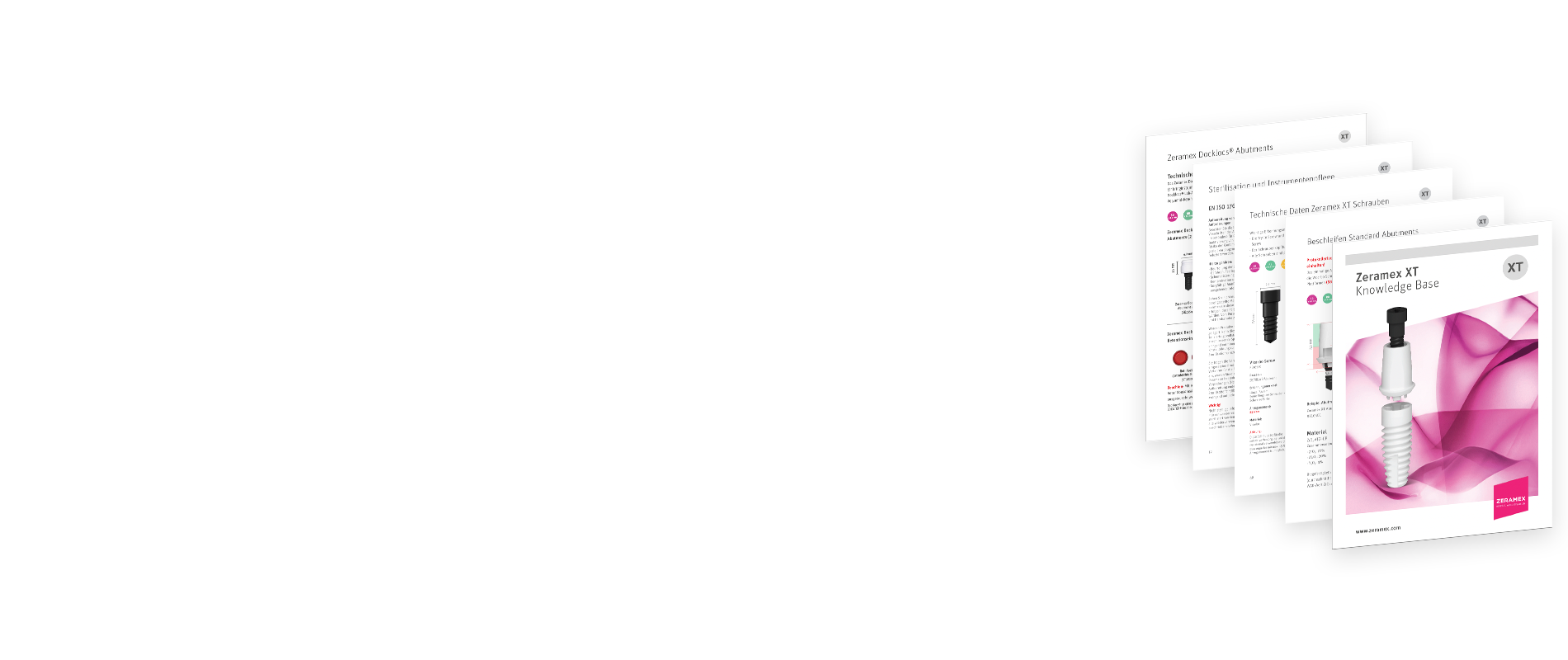Cleaning & sterilisation

> Do implants with healing caps need to be sterilised?
> Do abutments need to be sterilised?
> Does the Vicarbo screw need to be sterilised?
> Do the drills need to be sterilised?
> What needs to be considered during machine cleaning?
> When is ultrasonic cleaning recommended?
> What are the recommendations for automated cleaning?
> What are the recommendations for manual reprocessing?
> How should sterilisation be carried out?
Do implants with healing caps need to be sterilised?
No. Zeramex XT implants and healing caps are supplied sterile.
ATTENTION: If the packaging is damaged or not sealed tightly, the implants must not be used or re-sterilised. The same applies to expired implants. The manufacturer accepts no liability for re-sterilised implants. Observe the legal regulations and guidelines that apply to medical practices and hospitals in your country.
Do abutments need to be sterilised?
Medical devices that are delivered in a non-sterile condition (e.g. drills and abutments) must be sterilised before their first use on a patient. After use, all reusable medical devices must be reprocessed in accordance with the procedure described.
Does the Vicarbo screw need to be sterilised?
Yes. The Vicarbo Screw must be sterilised before its first use in a patient's mouth. Steam sterilisation should be carried out at 132 °C / 270 °F or 134 °C / 274 °F. Duration: 18 minutes.
Do the drills need to be sterilised?
Medical devices that are delivered in a non-sterile condition (e.g. drills and abutments) must be sterilised before their first use on a patient. After use, all reusable medical devices must be reprocessed in accordance with the procedure described.
What needs to be considered during machine cleaning?
For machine cleaning to be effective, it must be preceded by manual cleaning. This removes larger contaminants (blood, tissue and bone fragments). Rinse the instruments immediately after use under cold running water and remove large contaminants with a fine nylon brush. Then place the instruments in the cleaning tray of your disinfection and cleaning device.
When is ultrasonic cleaning recommended?
If the instruments are heavily soiled and it is not possible to remove larger contaminants manually, cleaning in an ultrasonic bath is recommended. Important: The cleaning agent must be compatible with the products. Please observe the exposure times and concentrations specified by the manufacturer.
What are the recommendations for automated cleaning?
Only use suitable cleaning and disinfection equipment for your automated cleaning tasks. These should be validated by the user on the basis of established cleaning processes. Place the parts in the cleaning tray in accordance with the equipment manufacturer's instructions. Commercially available cleaning agents and disinfectants are available. We recommend: ‘neodisher MediClean’ and ‘neodisher Z’ as neutralising agents (both from Dr. Weigert, Hamburg). Follow the manufacturer's instructions for dosage and application. We recommend fully desalinated water for cleaning the instruments and for the final rinse. The selected cleaning and disinfection programme should run at the optimum temperature for blood removal (45-55°C).
Example of a cleaning programme:
- Pre-rinse with cold water: 4 min
- Clean with alkaline detergent at 45-55°: 10 min
- Neutralise: 6 min
- Intermediate rinse: 3 min
- Disinfect: 5 min
- Dry (max. 130°C): 5 min
Before sterilisation, check the cleaned, dried and disinfected parts for corrosion and damage.
What are the recommendations for manual reprocessing?
After use, place the products in a disinfectant solution to prevent them from drying out and as a personal protective measure. Remove any large contaminants (blood, tissue and bone fragments). To do this, remove the instruments from the tray and clean them under cold running water with a fine nylon brush. Never use a metal brush or steel wool for this step!
Cleaning
Rinse the products with cold, deionised water before cleaning. To do this, dismantle all products that can be taken apart. A suitable cleaning agent is, for example, ‘neodisher MediClean’ (Dr. Weigert, Hamburg). Place the products in a fresh cleaning bath prepared according to the manufacturer's instructions. Clean the parts with a nylon brush. Rinse the products several times with deionised water and check them all for corrosion or damage.
Desinfection
To disinfect the products, place them in a fresh disinfectant bath. They must be completely covered. A suitable disinfectant is, for example, ID 212 Instrument Disinfection (Dürr System Hygiene).
Rinsing and drying
After disinfecting the products, rinse them thoroughly with fully desalinated water. Use residue-free compressed air to dry the instruments.
How should sterilisation be carried out?
Reassemble the dismantled medical devices before sterilisation. Sort the separately cleaned and disinfected products into the designated sterilisation tray. They can also be sterilised individually.
Then pack the loaded trays and/or individual products in disposable sterilisation packaging (single or double packaging) suitable for steam sterilisation and/or a sterilisation container. Packaging suitable for steam sterilisation must comply with the requirements of DIN EN ISO 11607/ ANSI/AAMI ST79/AAMI TIR12:2010. Examples: Single-use sterilisation packaging (single or double) with a temperature resistance of at least 134 °C (274 °F) and steam permeability that provides adequate protection against mechanical damage. Or sterilisation containers that must be regularly maintained in accordance with the manufacturer's specifications. Instruments such as drills, thread cutters and depth gauges are inserted into the Zeramex XT Surgery Tray (XT48850/XT48854) in the designated position for sterilisation. Sterilisation is carried out in an autoclave at 132 °C / 270 °F / or 134 °C / 274 °F with a minimum holding time of 18 minutes, followed by vacuum drying. The parts are then labelled with the sterilisation date and stored in a dry, dust-free place.
Didn't find the answer to your question?
Leave a comment
Comments
No comments have been posted yet.


